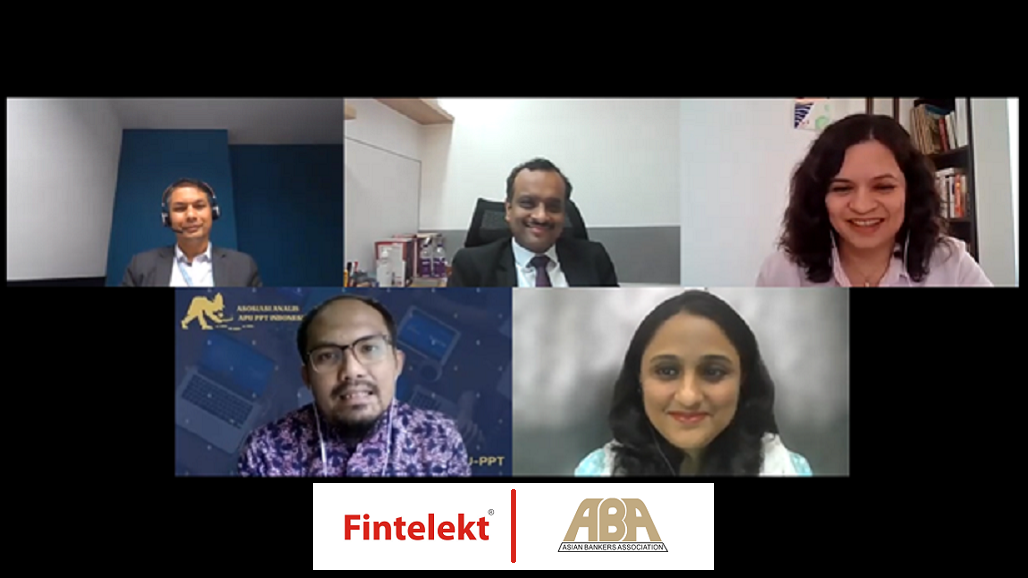The ABA-Fintelekt webinar on “The Role of Video-KYC in Digital Onboarding and Ongoing Due Diligence” held on April 12, 2022 established a new record in turnout with 1120+ registered participants from across 40 countries and an active audience that issued several dozen questions to the expert panelists.
The webinar was held as a panel discussion, moderated by Arpita Bedekar, Director – Strategy & Planning, Fintelekt Advisory Services and the panelists were Rafi Wisesa, AML-CFT Head, Bank OCBC NISP Indonesia, Sanjay Pant, Chief Risk Officer and Head of Conduct, Financial Crime & Compliance, Standard Chartered Bank Nepal, Arti Shekhar, Chief Compliance Officer, Kotak Mahindra Prime Limited and Vikas Gupta, Chief Compliance Officer, Canara HSBC Life Insurance.
(1) Key takeaways from the panel discussion
A typical process of completing a full KYC of the customer using the video-based method is to collect the customer’s document, make a video call through the bank/financial institution (FI)’s domain, conduct a face match using artificial intelligence, collect geo tagging/mapping information, conduct a liveliness check to ensure that the person in the video is real and live. IT checks for spoofing and bots are also conducted. Further, the customer’s data is matched with a national database or other government records.
During the pandemic and resultant lockdowns, video-KYC was a valuable tool for banks/FIs to continue to onboard and verify customers and keep providing online and mobile services.
(2) The benefits of Video-KYC in digital onboarding
The video-based KYC process as a part of digital onboarding has many benefits over traditional KYC. It is a contactless, paperless and convenient process with minimal documentation required from the customer. Costs are much lower, as physical verification is not required. There are also efficiency benefits as time taken is much lower compared with traditional KYC. The institution reduces dependence on human eyeballing and places more reliance on technology-based checks.
Banks/financial institutions can provide an enhanced experience for the customer as the latter can avail of video-KYC at their chosen time and using their preferred instrument. For the insurance industry, the added benefit is that of direct interaction with the customer, which can eliminate the risks associated with the agent such as conflict of interest and fraud.
“Video-KYC can bring benefits beyond onboarding. Insurance companies can create a digital hub or a journey for policy servicing as well.” – Vikas Gupta, Chief Compliance Officer, Canara HSBC Life Insurance
(3) Critical Success Factors
For countries where a national identity database is available centrally with the government, the process of Video-KYC is simpler. Hence regulatory involvement and a clear direction is critical for successful implementation.
“For countries like Nepal, currently the risks outweigh the benefits. For a greater adoption of video-KYC banks will need more clarity from the regulator and support in terms of a centralised database and technology.” – Sanjay Pant, Chief Risk Officer and Head of Conduct, Financial Crime & Compliance, Standard Chartered Bank Nepal
Technology implementation can be costly and has a steep learning curve. Hence it is important for banks/FIs to decide how advanced they want to be in terms of the technology that they implement – whether they want to use technology just to validate the customer’s ID or put in place face recognition and artificial intelligence.
Compliance teams also need to realign and understand the risks and put in place a mitigation plan. Risks include fraud risks as well as IT risks such as deep fakes, impersonation risk, spoofing, use of bots, etc. The regulator in India for example, mandates that security audits, vulnerability testing, anti-spoofing checks, etc. are done on a periodic basis.
Customers onboarded through video-KYC are not necessarily treated as high-risk customers. In fact, in some cases, the risk may reduce due to additional data of the customer such as location available for the bank/FI.
“Video-KYC is not just digital disruption, it should be viewed as an Opportunity. It is a win-win for both the bank as well as customer.” – Rafi Wisesa, AML-CFT Head, Bank OCBC NISP Indonesia
(4) Adoption of Video-KYC
An audience poll during the webinar showed that 58 per cent of attendees represented organisations that have not started implementing video-KYC.
Even in countries where video-KYC is allowed by the regulator, not all banks have jumped on to digital onboarding with many preferring to have face-to-face interaction with customers through branches and rely on e-KYC for digital onboarding.
Millennials are usually the target market for digital solutions of banks/FIs. Similarly, there is greater adoption in larger cities compared to remote areas where internet connectivity / mobile networks may not be as strong as in the larger cities.
“Video-KYC is relatively new and needs investments in technology and training. Once institutions see the success of others, especially large banks, we will see more adoption in the years to come.” – Arti Shekhar, Chief Compliance Officer, Kotak Mahindra Prime Limited
(5) Webinar’s video recording
A recording of the webinar is available on Fintelekt’s learning platform Fintelekt Academy HERE.
Registration on Fintelekt Academy, a learning portal on on-demand short training videos across a number of categories on AML/CFT issues, is free and more than 80% of the content is free to view HERE.


Leave a Reply